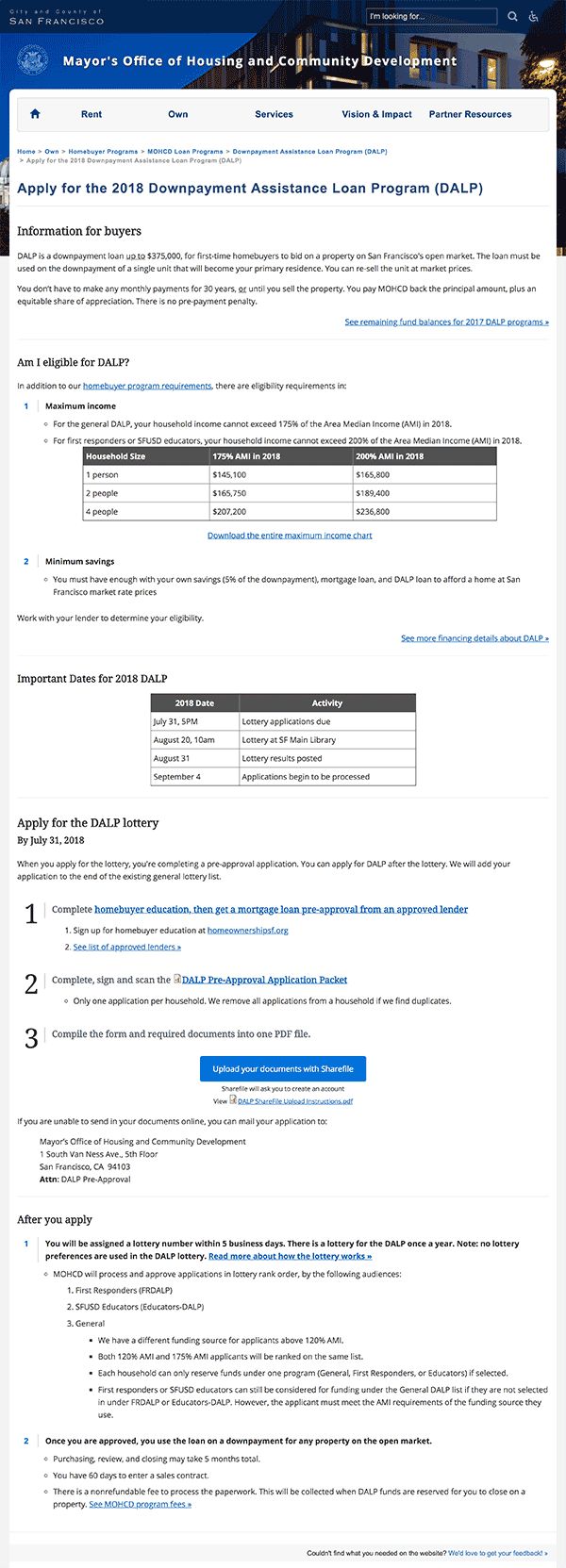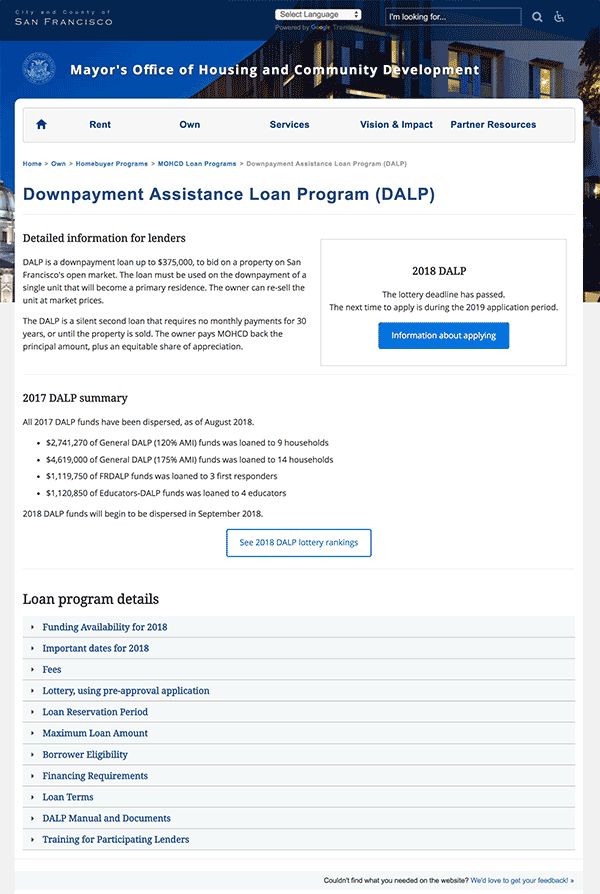How clear content can make living in San Francisco possible
In 2017, I moved from Los Angeles to San Francisco to work at the Mayor’s Office of Housing & Community Development (MOHCD). I told my friends that I was going to work on affordable housing there. I’d always append that with, “Yes, I know there is no affordable housing in San Francisco!”
But that doesn’t mean there aren’t people trying to change that.
Making San Francisco residency accessible
MOHCD is such a place. The people there envision “an equitable and diverse City where all residents can afford a place to live.”
MOHCD offers financial help for residents who need it for stable housing in the City. But offering such programs won’t make a difference if information about how to apply for it is still inaccessible.
That’s where I came in. My job at MOHCD was to restructure information on the website so our applicants could understand it.
The reality is that buying a home is just not easy!
When I arrived, MOHCD had already launched an online rental housing application. People who wanted to rent affordable apartments could apply for the lottery online. You could do it in minutes and be on your way.
Buying an apartment in a MOHCD program is not like that.
You have to go through a 6-hour workshop at an approved housing counseling agency. Then you have to meet one on one with a housing counselor to do a basic check of your finances. If you pass the basic check, you then go to a participating lender to get preapproved for a mortgage.
All that before you can even apply! If you miss any of those steps, it’s more headache for you, as well as MOHCD staff, to try to get it rectified before the lottery.
For many, the process looks so arduous that they don’t even try.
But for those who hang on, figuring which program to use can still be confusing!
Making homeownership possible for the “missing middle”
One of the programs I worked on was the Downpayment Assistance Loan Program, or DALP. It’s a loan program for people who are considered middle income. They need just a little boost for their downpayment when buying.
DALP provides a downpayment loan up to $375,000, on a market rate home in San Francisco. Every year, there is a limited amount of funds available to loan out. There is one DALP lottery every year to determine the order in which MOHCD staff go through applications.
That’s the absolute minimum you need to know to apply for DALP. And this was the original DALP page.
For those of you who work in government or have been to a government website, this kind of page looks very familiar. It’s a program page, and it shows everything anyone would ever want to know about that program. And I do mean “anyone”—applicants, lenders, policymakers, staff, and the general public.
If you wanted to apply, how would you do it? That was not clear on the original page. That had to change.
To make government services better, start with content
Why does content matter so much? It seems so…basic, doesn’t it?
Changing the way government services work is hard. It involves tearing down existing ways of working. Ways that have worked (or limped along) for years. Maybe even decades.
Once we tear down the old process, we have to replace it with a new one. And in government, once you start down one rabbit hole, you usually find 10 more to go down. It’s a transition that may take years and years. In the meantime, our residents continue to miss out on opportunities.
Language is access
Instead of changing how the process itself works, one stopgap is updating content. At least people will understand how things work, even if the process itself remains complicated.
Understanding your users’ needs is the best way to improve your content
It’s not enough to use smaller words. If information is not relevant or is presented out of context, it’s still hard to understand.
You have to know your users and what they need. And then organize your content accordingly.
San Francisco Digital Services does it by writing user stories based on real user research. Our template is from GOV.UK’s recommendation: “As a (someone), I need/want/expect to (do something), so I can (achieve some kind of criteria)”
After interviewing several homeownership applicants, I discovered that one main motivation for buying over renting was stability. People don’t want to be priced out of their home, or be evicted.
I wrote the following user story:
As a parent, I want to buy a home in San Francisco, so my children can stay in their school district.
Understand the process you’re writing about
Next, you have to learn about the thing you’re writing about. You can’t fake knowledge if your goal is to write clearly and directly. You have to know the ins and outs. Meet with subject matter experts (SMEs) to walk you through how things work.
One of the first things I did at MOHCD was to meet with each housing program manager and draw out their service on a whiteboard. I also met with them to pair-write the content together. In this case, I drafted up my ideas and then pestered the SMEs in person with questions that came up.
I told the staff, “I can’t write it if I don’t know it.” All of them were more than happy to share their knowledge and experience.
I drew out journey maps for every major service MOHCD had, and pinned them to the outside of my cubicle. It has become a reference for anyone working with MOHCD programs, to understand how it all works.
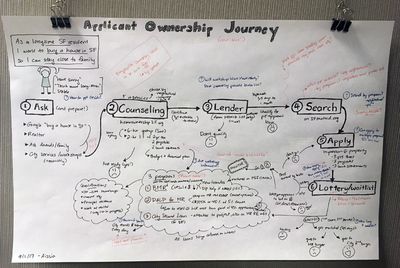
Structure your content to reduce cognitive load
Extensive research shows that people do not read everything on a webpage. They scan, reading only 20% of what you put on a page.
Saying “They didn’t read it, it’s their fault!” won’t do any good. The result is a lose/lose for everyone. Your readers miss opportunities, and your work has made no impact. The responsibility falls to us to make our content as easy to read as possible.
Do everything you can to reduce cognitive load.
One task, process, or audience need per page
The needs of a parent applying for a loan program is very different from the needs of a mortgage lender. An applicant just needs to know enough to apply. The lender needs to know financing details.
Having information for multiple audience needs on the same page increases cognitive load. Having information on multiple processes on the same page also increases cognitive load.
Everyone has to read the whole thing and pick out what’s relevant to them right now. That’s a lot of work, and people can assume wrong.
Make the information as relevant to them as possible. If it involves more than one audience need or task or process, split it off onto a new page. People don’t need everything at once.
When restructuring DALP content, I split it into two pages. One for applicants, and one for all other audiences who needed financing details. Those would include lenders, housing counselors, and even reporters.
Use the inverted pyramid
The inverted pyramid is a concept taken from journalism. The basic premise is to assume your user will stop reading your content at any time.
That means the most important information must be presented first. If the user stopped reading after the first sentence, they should have a general idea of what the page was about.
No more “welcome” or “thank you for reading” introductions. I start every page by answering the question, “So what is this thing anyway?”
I then create sections of content, and order that section by audience size. These sections of content are informed by the original user story: “As a parent, I want to buy a home in San Francisco, so my children can stay in their school district.”
What would someone need to know, to apply for an affordable housing program?
- Everyone wants to know if they’re eligible.
- If they are eligible, how to fulfill application requirements.
- If they are eligible and finish all requirements, apply for the program.
- Some will want to know what to expect after they apply.
- Very few people, if any, want to learn about the background or history of the program they’re applying for. Only if they’re real policy wonks!
The number of people who would want to read the content becomes smaller as they go down the page. That’s the idea of the inverted pyramid.
Present information where people will see it
In the quest for consistency, many people try to decrease repeated information. This can be confusing for readers who are scanning. It’s best to give them relevant information at the point where they’ll see it, even if it’s repetitive.
For all MOHCD homeownership programs, everyone needs to go to a workshop, meet with a housing counselor, and get a mortgage preapproval letter. It’s not technically a step to apply for DALP, because it’s assumed that you would already have all of that as a preapplication requirement.
We originally published a step by step that started with “fill out this PDF application” as the first item. Three out of the first 5 applications did not contain proof that they had gone to a workshop or gotten a mortgage preapproval. Clearly that wouldn’t do!
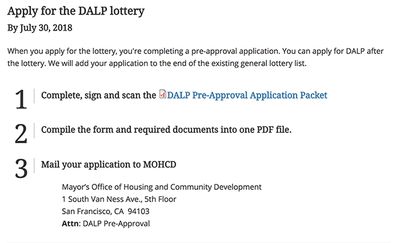
We then published a step by step that basically repeated the education requirement. But it was very obvious that that was the absolute first thing you had to do to apply. And then we had much less of a problem with applicants missing it.
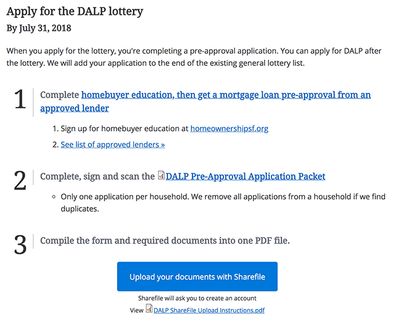
Write your copy for a wide audience
Honestly, once you’ve taken care of structuring the content, you’re more than halfway there.
But there are a lot of tips on how to write copy in plain language. I’ll run through some that I’ve found make the biggest impact.
1. Be active
Your user has agency. You’re not doing something for them, you’re empowering them to do things for themselves.
People use websites or apps to achieve a task. Make it clear what the task is, such as “Apply for…” instead of “[Program name] application process.”
In the same vein, opt for active voice over passive voice. An example is “You can resell the unit at market prices” vs “The unit will be resold at market prices.” Using active voice makes it clearer who is doing what.
2. Think short
Shorter sentences are easier to parse. Have only one idea per sentence. Aim for 15 words per sentence, maximum. Aim for 3 sentences per paragraph, maximum.
You can’t stop people from scanning, but you can signal where a different section starts by using subheadings. (Also, people using screenreaders will navigate through a page just using subheadings. Use them liberally!)
If you’re going to have a long list separated by commas, use bulleted lists. If it’s ordered instructions, use numbered lists.
A bonus is that Google Translate has a much easier time with shorter sentences. It’s much harder for software to parse a sentence with multiple clauses. If you find yourself typing in a comma, try replacing it with a period and starting another sentence.
3. Write like you talk
We were all taught in school to write like we wanted to seem smart. The bigger words we used, the smarter we’d seem. Unfortunately, that ignores the fact that the average reading level in the US is Grade 8. Everything you were taught about SAT words, AP tests, and college essays is actually not helpful! You have throw all those rules out the window if you want to write for as many people as possible.
San Francisco Digital Services aims for Grade 5 or 6, using Hemingway App as a guide. We don’t always get there, but it’s the goal!
The original DALP page was at a Grade 11 reading level. The new DALP page is now at a Grade 7 reading level. It was admittedly Grade 6 before we started adding more detail to it. But it’s important to try to push it as low as possible, before government starts creeping back in!
We’ve almost made it into a contest. I end all my drafts with a note about the reading level. That way, city stakeholders can see it and try to keep it low. (This blog post? Grade 5!)
4. Use “you” and “we” if it’s clear
Nothing alienates a user more than reading “the applicant” or “the department” down a webpage.
Think of the page as a conversation. You are the author, and are talking to the reader. For government services, there’s going to be action taken on both sides during any process.
When it was clear that there was one author and one reader, I used “you” to refer to the applicant. I used “we” to refer to MOHCD. It’s a lot warmer and more direct to read.
Take a look at more of our writing tips on the San Francisco Digital Service’s content style guide.
Collaborate to leverage content
I may have written the words, but I couldn’t have done it alone. Collaboration across roles is necessary, for content operations as well as marketing that new content.
Have open communications with program staff
Folks who are on the front lines will tell you when the content can be improved. They get calls and emails from the public, after all! They are also the first to notice when the content is improved.
I make it clear that anyone can contact me if there is an issue that can be solved by updating content. Having clear and accurate content is the first step toward earning your users’ trust. Presenting inaccessible, outdated content can lose their trust. You need collaboration to make sure the content is the best it can be.
Work across roles to boost impact
I was not the only person at MOHCD working on communications with the public. We had Kim Dubin, a FUSE Corps executive fellow who did all of the public relations work.
It was great because I could focus on delivering content to improve services. I didn’t have to attend press conferences or talk to reporters. Kim did a wonderful job connecting people to the content, and letting me know when the website needed more.
For DALP, it culminated in an SF Chronicle article that laid out all of the eligibility requirements I had already laid out. The article encouraged people to apply, and soon our office was inundated with calls from interested applicants.
The combination of the SF Chronicle article and the improved application content made an impact. In 2017, 198 people successfully applied for DALP. In 2018, 266 did, an increase of 34%.
What’s next?
Writing relevant, clear content is proven to improve services. But we can do more in government.
There was a NYTimes article back in May, that talked about how 6,580 San Franciscans applied for a lottery to rent 95 apartments. DALP is similar—it has a lottery too.
The 266 applicants are currently ranked on a lottery result list. MOHCD staff will go through their paperwork in that order. In 2017, they got through about 80 applications and loaned to 23 households before funds ran out.
My efforts in increasing the number of DALP applicants only gave more people a chance. It doesn’t actually help more people. What actually helps more people is having more availability. It means having more housing, and it means having more funds to loan.
As a city employee, official policy is that I can’t tell you how to vote.
But I can tell you that your vote matters. I can tell you that this year, we have 116% more DALP funds to loan out because San Francisco voters overwhelmingly approved Proposition A back in 2015.
Better services can give more people access. But what will make huge strides is in policy changes and civic engagement. And we hope content can help do that too, in talking about impact and connecting the dots.
Content is here to stay, and we certainly hope that it continues making a real difference in people’s lives.
I spoke about this topic at a Designers + Geeks event in San Francisco on November 15, 2018, called “Designing for Inclusion.” There is video from the talk!


